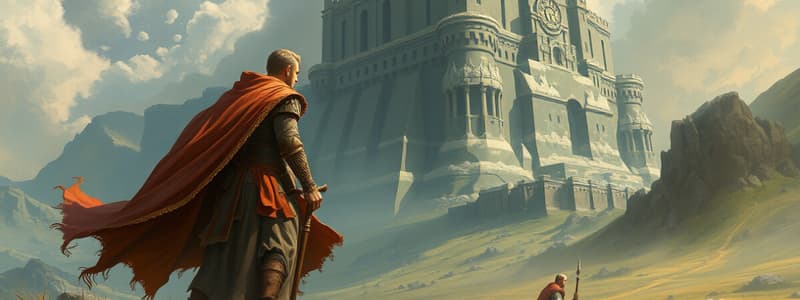Podcast
Questions and Answers
What is notable about The Book of Kells?
What is notable about The Book of Kells?
- It contains the Latin text of the five Gospels.
- It was not affected by Viking raids.
- It is illuminated with at least ten colors. (correct)
- It was completed in the year 1000 CE.
Which character is associated with English epic literature?
Which character is associated with English epic literature?
- Boudicca
- Achilles
- Beowulf (correct)
- El Cid
Who were the Druids?
Who were the Druids?
- Political leaders of the Britons.
- The first Roman invaders of Britain.
- Priests for the Celtic people. (correct)
- The primary warriors of the Celtic people.
What does the character Grendel represent in English literature?
What does the character Grendel represent in English literature?
When did Julius Caesar first invade Great Britain?
When did Julius Caesar first invade Great Britain?
What action did Claudius take regarding the island?
What action did Claudius take regarding the island?
What was the purpose of Hadrian commissioning a wall?
What was the purpose of Hadrian commissioning a wall?
Who hired mercenaries to conquer Britain?
Who hired mercenaries to conquer Britain?
What method did Vikings predominantly use during their attacks?
What method did Vikings predominantly use during their attacks?
What characterizes the values of Anglo-Saxon culture?
What characterizes the values of Anglo-Saxon culture?
Flashcards are hidden until you start studying
Study Notes
El Cid and Epic Literature
- El Cid is a significant figure in Spanish literature, representing heroic ideals.
- Anglo-Saxon literature features notable works such as Beowulf, which is the first major text in English.
- Grendel is a key antagonist in Beowulf, illustrating the theme of good versus evil.
- Achilles from Greek literature represents the archetype of the tragic hero.
- The French epic, Roland, highlights themes of loyalty and chivalry.
The Book of Kells
- Created around 800 CE, this illuminated manuscript contains the Latin text of the four Gospels.
- Uses at least ten colors; only two of its 680 pages lack color, showcasing intricate artwork by monks.
- Survived Viking raids and was housed at the Abbey of Kells.
Early Britain and the Celts
- Britons practiced polytheistic and animistic religions, with Druids serving as priests.
- Legends include strong female figures, such as Boudicca.
Roman Invasions
- Julius Caesar's initial invasion led to temporary occupation; Claudius later solidified Roman control.
- Hadrian's Wall was built for defense against Celtic tribes, representing Roman administrative capability.
- Roman withdrawal left behind infrastructure, but the Celts regained land, resulting in renewed tribal warfare.
Invasion by Invitation
- King Vortigern invited Scandinavian mercenaries, Hengist and Horsa, to Britain, leading to further invasions.
- King Arthur is a legendary figure, representing hopes for strong leadership during turbulent times.
Viking Influence
- Vikings initially employed hit-and-run tactics, later establishing control over areas known as Danelaw.
Anglo-Saxon Culture
- Cultural values emphasized courage, honor, loyalty, and sacrifice, defining their warrior society.
- Relationships between warlords and their followers (thanes) were central to maintaining kingdoms.
Anglo-Saxon Beliefs
- Anglo-Saxons were pagan and superstitious, focusing on fame as a form of immortality.
- They believed in magic, dragons, and a world viewed as unpredictable and perilous.
Literary Techniques
- Alliteration was a primary sound device, vital for the oral tradition of Anglo-Saxon poetry.
- Caesura provided natural breaks in poetry, aiding memory for oral recitation.
- Kennings, compound metaphors, were used extensively; about a third of Beowulf consists of kennings, illustrating their importance in the poetic form.
Studying That Suits You
Use AI to generate personalized quizzes and flashcards to suit your learning preferences.





